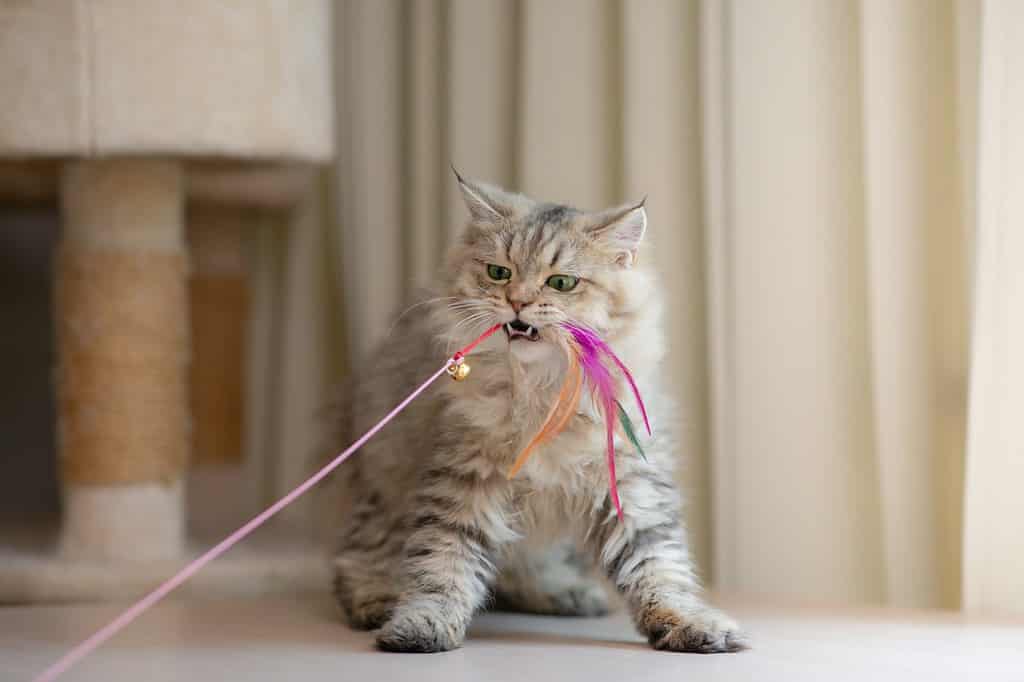A yelp from the litter box is a startling sound but it’s more unnerving when your kitty hides its pain. Whether it’s a diet change, a recent injury, or an underlying health condition, constipation in cats requires immediate attention. Learn more about constipation in cats, including causes, symptoms, and treatments!
What Causes Constipation in Cats?
Dr. Colleen Wallace, a cat-only vet at Cozy Cat Veterinary Hospital in Raleigh, NC told A-Z-Animals, “Constipation can happen to young or old cats, but with different causes. In old cats, it is usually secondary to diseases that cause dehydration, such as diabetes, hyperthyroidism, and especially chronic kidney disease. Vets are not sure why younger cats develop constipation, but it could be that they are not drinking enough to stay hydrated.”
Foreign Body
If your cat has ingested a non-food item, it may cause some tummy trouble. Cats can suffer from a condition called pica, which is when they are attracted to inedible items. This could be strings, paper, cardboard, and even cat toys. Once the item makes it to the colon, it is expelled in the feces, but your kitty may experience constipation until this occurs.
Hairballs
Long-haired cats can be fastidious groomers, considering they have much more to work with than short-haired cats. Although they appear lustrous and pristine, they do have to deal with the consequence of hairballs. If a hairball gets to be too big, your cat may have trouble passing it, resulting in constipation.
Obesity
A cat that is at least 20% above its normal weight is considered obese. Obesity in cats is linked to a range of issues, including constipation. If your cat is obese, it experiences intestinal inflammation. In turn, the body’s intestinal processes slow down considerably, which affects stool movement.
Lack of Exercise

You can help your cats remain active by playing with them for 15 to 20 minutes twice per day.
©ANURAK PONGPATIMET/Shutterstock.com
When your cat is active, its body functions optimally, including its digestive system. Regular activity helps keep your cat regular. However, when a cat leads a mostly sedentary life, slow bowel movements may be a consequence along with weight gain, which only contributes to the problem.
Injuries
If your cat experiences a pelvic injury, the pelvic canal may narrow, which could lead to constipation. Unfortunately, in some cases of constipation, megacolon may develop. Megacolon occurs when the colon is weak, and constipation has become severe.
Medications
Certain medications for cats, like opioids, list constipation as a side effect. These medications may disrupt a cat’s regular digestive functioning, so owners may notice that bowel movements slow down. In these cases, a laxative like Miralax may help.
Symptoms of Constipation in Cats
Decreased Appetite
If your cat is unable to clear its colon, you may notice that it loses interest in food. If your normally enthusiastic eater is turning its nose up at its favorite treat, it may be experiencing constipation.
Abdominal Pain
Like humans, cats experience abdominal discomfort and pain when they’re unable to excrete waste regularly. Cats are good at hiding their pain, but watchful owners know when something is up. Your kitty may be hiding, crouching, or circling the litter box if it’s experiencing pain from constipation.
Swollen Belly

You may notice your cat has a swollen belly when it’s constipated.
©New Africa/Shutterstock.com
It’s harder to tell if your cat is extra fluffy, but you may sometimes be able to see (or feel) your cat’s swollen belly when it’s constipated. There’s food in there that hasn’t made it out so your cat may experience a swollen or bloated tummy.
Vomiting
If your cat is constipated, it may appear to have a decreased appetite, but it may also experience vomiting. Vomiting can be a symptom of other conditions, however, so it’s important to look for other symptoms and speak with your veterinarian if you’re concerned about health changes.
Stiff Walking
When your cat is backed up, it experiences discomfort. This may become obvious by the way its normal gait turns into more of a stiff walk.
Straining
One of the most obvious signs of constipation in cats is when they’re in their litter box, straining to go without success. When they’re straining, they may cry out in pain.
Treatment for Constipation in Cats
IV Fluids/Hydration
If your cat has not had a bowel movement in two to three days, it’s time for a vet visit. Your vet may administer IV fluids to help things move along. However, if the feces are impacted, they may try something else.
Enema

In some cases, a cat may require an enema to help move things along.
©Oksana Smyshliaeva/iStock via Getty Images
If feces are impacted and your kitty won’t be able to have a bowel movement on its own, your vet may perform an enema. Using a syringe and catheter, your vet administers the enema to release the impacted stool. Typically, stool movement occurs rather quickly following an enema.
Dietary Changes
If constipation doesn’t require an emergency vet visit, you can work with your vet to determine which foods may help your cat maintain regular bowel movements. Fiber-rich foods and those with a high moisture content can help your kitty stay regular. Additionally, you may want to introduce a water fountain over still water to encourage more drinking.
Laxatives
Your vet may also recommend trying a laxative like Miralax, which you can purchase over the counter, to sprinkle into your cat’s food to treat constipation and offer your cat some much-needed relief.
The photo featured at the top of this post is © iStock.com/Axel Bueckert
Thank you for reading! Have some feedback for us? Contact the AZ Animals editorial team.






